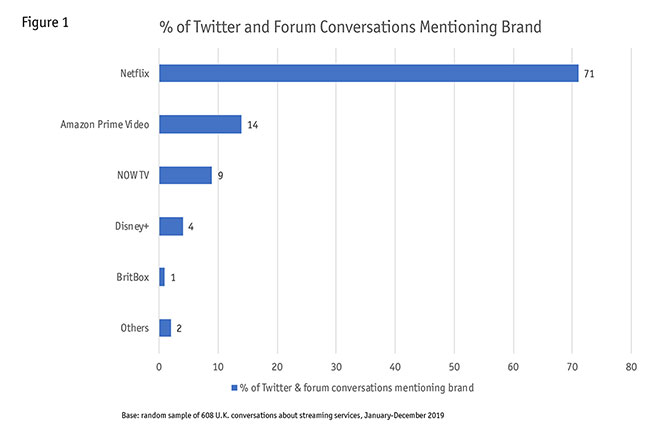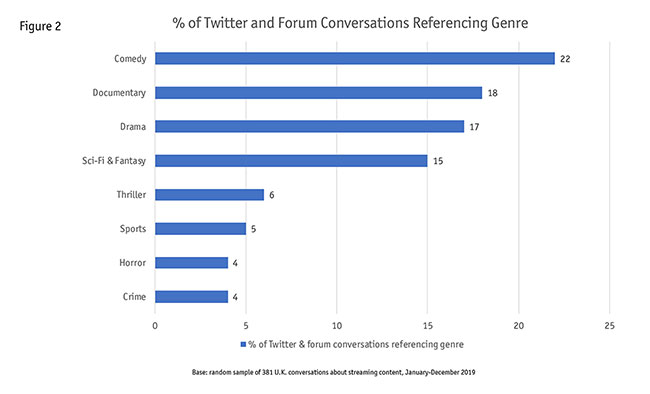Netflix and BritBox and Amazon, oh my!
Editor's note: Hannah Lendrum is social insights manager at research firm Join the Dots | InSites Consulting, Manchester, U.K.
 2019 was an interesting year for streaming in the U.K. Netflix remains huge as we enter 2020 but Amazon Prime Video continues to grow and new players such as BritBox and Disney+ pose a potential threat to established services. Looking back at online conversations about streaming over 12 months, the Social Intelligence team at Join the Dots | InSites Consulting identified seven “must-knows” for media brands in 2020.
2019 was an interesting year for streaming in the U.K. Netflix remains huge as we enter 2020 but Amazon Prime Video continues to grow and new players such as BritBox and Disney+ pose a potential threat to established services. Looking back at online conversations about streaming over 12 months, the Social Intelligence team at Join the Dots | InSites Consulting identified seven “must-knows” for media brands in 2020.
1. Netflix dominates by a long way
Based on Twitter and forum conversations in 2019, Netflix remains dominant in the market and not yet threatened by established or emerging streaming services: 71% of online conversations about streaming services over the last year referenced Netflix – five times as many as the next platform (Figure 1).
“Netflix and chill” entered common parlance a few years ago and the way people talk about Netflix continues to prove how far it has penetrated public consciousness. Unlike other services, where people tend to reference watching specific shows, Netflix is the only platform where the act of “watching Netflix” is an activity in itself.
 “In bed with a takeaway watching Netflix. We’ve turned into slobs and I love it!”
“In bed with a takeaway watching Netflix. We’ve turned into slobs and I love it!”
Similarly, Netflix is the only streaming service so established as to be used as a punchline, from asking when Netflix will produce a “Brexit saga” series to fast-forwarding Parliament on live TV.
“Laughing at Trump and his impeachment but you just get that feeling that Boris Johnson’s reign will end on a similar theme in 5 years. And you know Netflix are going to email me with their new doc series about this in 2040.”
After Netflix, Amazon Prime Video was the second-most talked-about service last year, although conversation volumes were significantly lower. However, certain shows such as Good Omens, The Boys and Lucifer (shared with Netflix) generated buzz for Prime, as well as the launch of the service’s Premier League livestreaming.
2. Content doesn’t matter if your platform doesn’t work
When it comes to streaming, content was, of course, the most-talked about topic. Sixty-six percent of conversations referenced a specific show, film or livestream. However, for certain services (most notably NOW TV), issues with functionality got in the way of people enjoying content, with many taking to Twitter to complain.
For some, issues with functionality even overshadowed the Game of Thrones finale, one of the biggest TV events of 2019.
“My NOW TV account stopped working! stayed up until 2am so I could watch game of thrones and now I can’t even wtf”
Issues with basic functionality can trigger people to cancel subscriptions to services, even when they like the content. Good service is a basic requirement for a streaming platform and one that is well worth investing in.
“How come for the past few weeks my access to Now TV has been intermittent? I’m fed up of paying for something I only get half of the time!”
In contrast to NOW TV, only 3% of conversations about Netflix referenced functionality. This can be seen as a reflection of fewer functionality issues, as well as a larger content range to talk about instead.
The other main gripe of viewers in 2019 was with content being removed from streaming services without fair warning or shows being cancelled/not renewed. For certain shows this generated a wave of negative comments from fans online. Notable examples included Netflix cancelling fan-favorite One Day at a Time and Santa Clarita Diet and NOW TV removing early episodes of Game of Thrones.
“@netflixUK you are doing my head in. Why do you keep cancelling shows in their early seasons? not sustainable yano. #santaclaritadiet”
3. People talk about TV shows more than films
Of all conversations reviewed, 39% referenced TV series, almost double the number talking about films (21%). Across both TV and film, comedy and documentary were the most-mentioned genres, closely followed by drama and sci-fi/fantasy (Figure 2).

Within comedy we found the most talked-about shows were After Life and Sex Education – two homegrown comedy series on Netflix. The Boys (Prime) and One Day at a Time (Netflix) also generated some conversation. The most popular shows were often those bringing a new spin to the genre, such as The Boys’ irreverent take on the cult of superhero, or One Day at a Time’s representation of a Hispanic family and LGBTQ characters within a traditional sitcom formula.
The most-mentioned documentaries were The Disappearance of Madeleine McCann and The Game Changers, both on Netflix. Music documentaries also proved a talking point on Netflix, notably Taylor Swift’s Reputation, Beyoncé’s Homecoming and Motley Crüe’s The Dirt. This genre may be a growing source of interest over the next few years. Other TV hits generating conversation included Lucifer (Netflix) and of course, Game of Thrones (NOW TV).
Within film, Marvel and Star Wars were mentioned often, in particular The Mandalorian, which will be available on Disney+ when it launches in the U.K.
What is striking was the sheer number of different shows and films being mentioned, making it difficult to find a real standout of the year. The diversity of content on streaming services can be a double-edged sword – while many are positive about it, some complained of being overwhelmed, of finding it difficult to choose what to watch or not having enough time to keep up with new additions.
“I really hate spending ages scrolling through content on Netflix and Prime looking for something to watch. If Apple can solve that then they are on to a winner.”
The sheer range of content on streaming services also means that fewer people are watching any given show at any given time, which reduces the chance for content to go viral. This has already proven to be a disadvantage when compared to linear TV, which tends to be better at achieving virality with a more limited selection of shows, broadcast at specific times.
4. Livestreaming sports is growing in importance
Livestreamed sports were a growing topic of conversation throughout the year as people tuned in to Amazon Prime Video and NOW TV to watch tennis, American football and the Premier League. The addition of Premier League games to Prime was big news. Many welcomed the news, in the hopes it may bring changes to the way the game is currently televised.
“Ngl I’m excited for football on Amazon prime. And I would love them to take over PL football rights if it meant they would stream every match including 3pm kickoffs.”
However, the experience was marred for many by slow buffering times and what some saw as a poor picture quality compared to traditional channels.
“Last night when I had the City game on – I saw on Twitter that City had scored before I did watching the game.”
Livestreamed sports are only set to grow this decade but this is an area where a good stream quality is absolutely key to enjoyment, making this a clear priority for sports streaming services to invest in over the next year.
5. Buzz is growing for Disney+ but less so for BritBox
In November, fans expressed excitement online about the news that Disney+ would launch in the U.K. in March 2020. Clever content reveals helped add to excitement, in particular the news that the Star Wars spinoff series The Mandalorian will be exclusively available on Disney+, although the prospect of waiting months to stream the show prompted others to explore workarounds for accessing it.
“It amuses me that @disneyplus think I’m going to wait until March to watch @themandalorian because I live in the UK. Nope.”
Compared to Disney+, conversation about ITV and BBC’s recently launched streaming service BritBox was minimal. Despite some success in the US, conversation this side of the pond was largely negative, with U.K. license payers complaining about the prospect of paying for previously free content.
“A subscription service where I can watch repeats of repeats, and pay for the privilege, in spite of the fact that I already pay a licence fee? Daylight robbery much?”
Despite this, the 30-day free trial was enough to encourage some to dip a toe into the water, with Doctor Who and classic box sets particular draws.
“I’m hiding away from my problems with a bacon buttie and Midsomer Murder. Decided to make the most of 30 free days from Britbox and start from the very beginning of the TV series.”
6. Viewers are trying to create a more social experience
One thing evident on Twitter and online forums is that people are trying to create more of a social experience around the shows that they’re watching. This came in the form of people asking their network for content suggestions, highlighting the importance of peer recommendations.
“Looking for a new series on Netflix to watch. What has been your favourite recent release?”
People also shared content they’d watched, and tried to generate discussion around it.
“Is anyone else watching You Me Her on Netflix? ????”
While some platforms are experimenting with peer recommendations (e.g., “what people are watching in your area” or “people like you watched…” lists), there has been no real move to incorporate social features or recommendations based on friends, into platforms yet. It will be interesting to see if this changes in 2020, particularly with the growth of services that have a more focused content stream and where users may have more in common with each other.
7. Those with multiple subscriptions may start to cut down
With the streaming market fragmenting further, some viewers started to worry about the rising cost of having multiple services and considered cutting down their repertoire, with two or three seeming the max for many.
“As much as I’d like to get Disney, not sure I can afford ANOTHER streaming service. I’ve got Netflix and Amazon but that’s enough. Probably get rid of Amazon as the video service isn’t great. But it’s the creeping £10 a month for multiple services that gets you.”
This hints at a lack of loyalty when it comes to streaming services – we saw people talking about switching if the functionality wasn’t up to par or the content range wasn’t refreshed often enough. Streaming services will need to be competitive on all fronts to keep subscriber numbers up, especially as newer platforms start to take content back from the current big players; one Twitter user described Netflix as looking “bare” if it loses its rights to both Marvel and BBC content.
“My real question is, will #BritBox result in the removal of BBC shows from Netflix? With everyone creating their own streaming services now, Netflix is looking a bit bare. I’m looking at you, Marvel.”
Ensure a healthy mix
In the short term, services will need to ensure a healthy mix of exclusive content and/or original programming but must also be aware that in the longer term, consumers may grow increasingly dissatisfied with content dispersed across different platforms and that the appetite for aggregated services is likely to grow.
